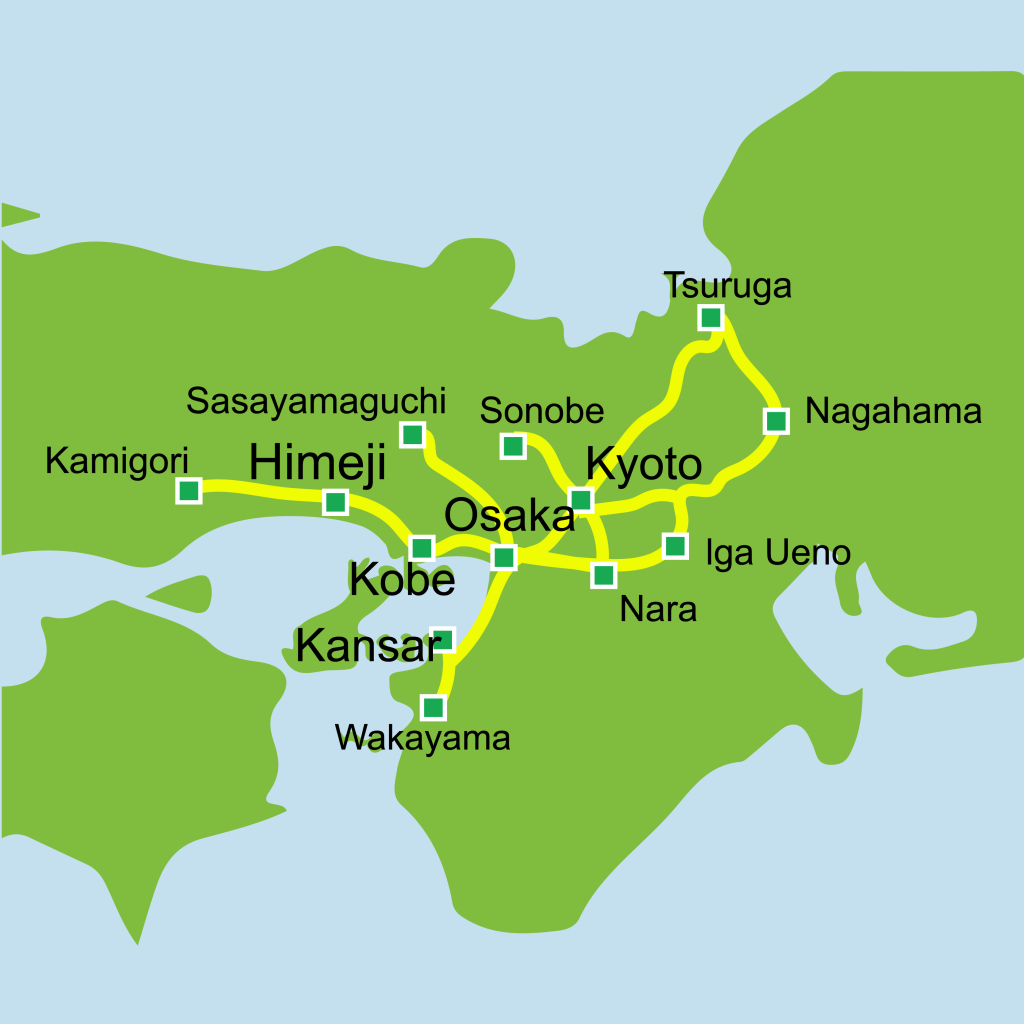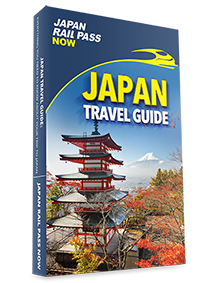JR West Kansai Pass / Kansai Area Pass
If you want to explore the major areas within Kansai and save money, then the JR West Kansai Pass is for you. Valid for 1, 2, 3, or 4 consecutive days, the pass allows unlimited rides on JR trains and select JR buses. You even get a day to take non-JR trains as often as you want on your chosen day.
Does that sound good to you? Then let’s look at the JR West Kansai Pass in detail.

Eligibility
This pass is only available to those on a temporary visitor status. A valid foreign passport showing this status is required when exchanging your MCO voucher for the pass. Additionally, individual passengers are NOT allowed to purchase more than one pass for the duration of the same ticket.
Price
The JR West Kansai Pass is available as a 1, 2, 3 or 4-day pass. Kids aged 6-11 are eligible for discounted tickets. The prices are the same regardless of whether you purchased your voucher via a travel agent outside of Japan, online at the JR West Online Train Reservation website, or at a JR West station office.
Price from 1 October 2023
| Adult Pass Price | Child Pass Price | |
| 1-Day Pass | A$30* (2,800 yen) | A$15* (1,400 yen) |
| 2-Day Pass | A$51* (4,800 yen) | A$25* (2,400 yen) |
| 3-Day Pass | A$61* (5,800 yen) | A$31* (2,900 yen) |
| 4-Day Pass | A$74* (7,000 yen) | A$37* (3,500 yen) |
How to Exchange the Voucher
In order to get your JR West Kansai Pass without any issues, here are a few pointers you must remember:
- Your exchange voucher is valid for three months from the date of purchase.
- Travellers aged six or older must have a voucher and a valid foreign passport in order to obtain a pass. You cannot get it without a foreign passport.
- Confirm the date you want to exchange your voucher. Once you get your pass, the timer timer starts and cannot be modified.
- Any unused MCOs are refundable minus a 10% handling fee (220 yen minimum per pass). The MCO must be within a year of its purchase date and hasn’t been used yet in order to be eligible for a refund.
- You can only request a refund at the station where you exchanged or purchased the pass. Refunds for overseas vouchers must be requested from the travel agent who sold them.
- If refunding the pass itself, it must be unused. You must bring four items with you: the pass itself, the Keihan Railway voucher, the Kyoto City Subway voucher, and the Hankyu Kyoto Line 1-Day Pass. They must not be activated yet in order to be eligible for a refund.
Here’s a list of where you can exchange your MCO:
- Kyoto Station – 6:30 a.m. to 9 p.m. daily
- NTA TiS Kyoto Branch – 10 a.m. to 12 p.m. and 1 p.m. to 4 p.m. daily
- Shin-Osaka Station – 6 a.m. to 10 p.m. daily
- Shin-Osaka Travel Service Center – 8 a.m. to 10 p.m. daily
- Osaka Station – 6 a.m. to 10 p.m. daily
- Kansai Airport Station – 5:30 a.m. to 11 p.m. daily
- NTA TiS Osaka Travel Service Center – 10 a.m. to 1 p.m. and 2 p.m. to 6 p.m. daily
- Sannomiya Station – 6 a.m. to 10 p.m. daily
- NTA TiS Sannomiya Branch – 11 a.m. to 6 p.m. on weekdays; 11 a.m. to 5:30 p.m. on Saturdays and holidays; closed Sundays
- Nara Station – 8 a.m. to 8 p.m. daily
- Wakayama Station – 6 a.m. to 10 p.m. daily
How to Use the Pass
The JR West Kansai Pass must be shown to staff before passing through the station gates. Seat reservations can be made online or at a station office.
If you’re using the other vouchers that came with your pass, present the pass and the voucher together to a station attendant. You can activate those vouchers anytime during your pass validity period.
Validity and Exclusions
Your JR West Kansai Pass is valid for 1, 2, 3, or 4 consecutive days. The first day starts the moment you receive your pass, and the next day starts at 12 a.m. Please keep this in mind when planning your trip and exchanging your voucher.
The other vouchers issued with your pass are valid for one day but can be activated anytime within the pass validity period.
The pass can be used for unlimited rides on these services:
- Reserved seats on the Kansai Airport Express, “Haruka”
- Local JR West Train Lines
- Rapid and Special Rapid JR Services
- JR West Bus Routes between Kansai Airport, Tennoji, Nishikujo, Osaka, Shin-Osaka, and Kyoto
The pass cannot be used for the following:
- Reserved and unreserved express trains, excluding the Haruka.
- The Special Rapid “A Seat” paid seating service.
- Any Shinkansen
- Expressway buses
- Any other local JR West Bus that doesn’t go between Kansai Airport, Osaka, and Kyoto
This is not available to residents of Japan or those without a temporary visitor status.
Kansai, the cultural heartland of Japan, has been the epicentre of its historical and political life for more than a millennium. The ancient imperial capitals, Kyoto and Nara, bestow upon Kansai a rich heritage that is unrivalled and unique.
The region is a blend of the old and the new, offering travellers a chance to experience both the tranquillity of its World Heritage Sites and the bustling energy of modern urban centres like Osaka and Kobe. Whether you are a history enthusiast, a foodie, or a shopping addict, Kansai has something for everyone.
“Kansai is not just a destination; it’s an experience that touches the soul.”
The Warmth of Kansai
Kansai is often associated with the friendly demeanour of its inhabitants and the soothing melody of the regional dialect, Kansai-ben. The locals’ warm welcome is a trademark of the region, making every visitor feel at home.
Discovering Kansai’s UNESCO World Heritage Sites
Kansai boasts more UNESCO World Heritage Sites than any other region in Japan. This is a testament to its significant role in the country’s history and the impressive preservation of its monuments, which have survived wars and natural disasters.
With the Kansai Area Pass, travellers can embark on a day or multi-day journey to some of Japan’s most stunning sites:
- Himeji Castle
- Buddhist Monuments in the Horyu-ji region
- Historical Monuments of Ancient Nara
- Mozu-Furuichi Kofun Group: Mounded Tombs of Ancient Japan
- Sacred Sites and Pilgrimage Routes in the Kii Mountains
- Historical Monuments of Ancient Kyoto (Cities of Kyoto, Uji and Otsu)
Himeji Castle
Himeji Castle, also known as “White Heron Castle” due to its brilliant white exterior, is one of the most spectacular examples of Japanese castle architecture.
The Horyu-ji Region
The Horyu-ji region is home to some of the world’s oldest surviving wooden structures, which are of immense historical and cultural value. The Buddhist monuments in this region offer a serene spiritual experience.
Historical Monuments of Ancient Nara
Nara, the first permanent capital of Japan, is replete with historical monuments that transport you back in time. Its grand temples, shrines, and the world’s largest bronze statue of the Buddha make it a must-visit destination.
Mozu-Furuichi Kofun Group: Mounded Tombs of Ancient Japan
The Mozu-Furuichi Kofun Group represents an era of ancient Japan, with its large burial mounds surrounded by moats. These tombs offer an intriguing insight into the lives of the powerful rulers of the time.
Kii Mountains’ Sacred Sites and Pilgrimage Routes
The Kii Mountains are home to three sacred sites – Yoshino and Omine, Kumano Sanzan, and Koyasan. These sites, along with the pilgrimage routes, are deeply rooted in the spiritual history of Japan.
Historical Monuments of Ancient Kyoto
Kyoto, the former imperial capital of Japan, is a city that exudes elegance and charm. The historical monuments of Kyoto, Uji, and Otsu, from temples to palaces, are a delightful blend of beauty, tradition, and culture.
Conclusion
Exploring Kansai is like stepping into a time machine that takes you on a journey through Japan’s rich history and vibrant modern life. The region’s UNESCO World Heritage Sites, bustling cities, delicious local cuisine, and the warm hospitality of its people make it a truly unforgettable destination.









